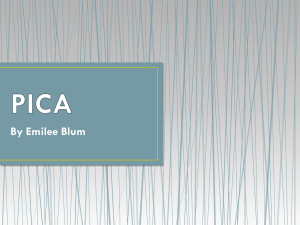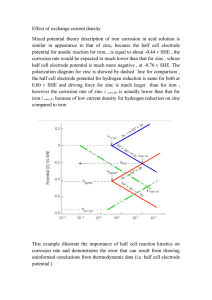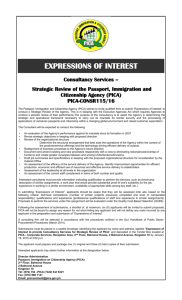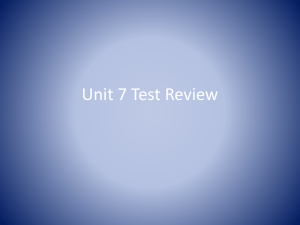Document 13310007
advertisement
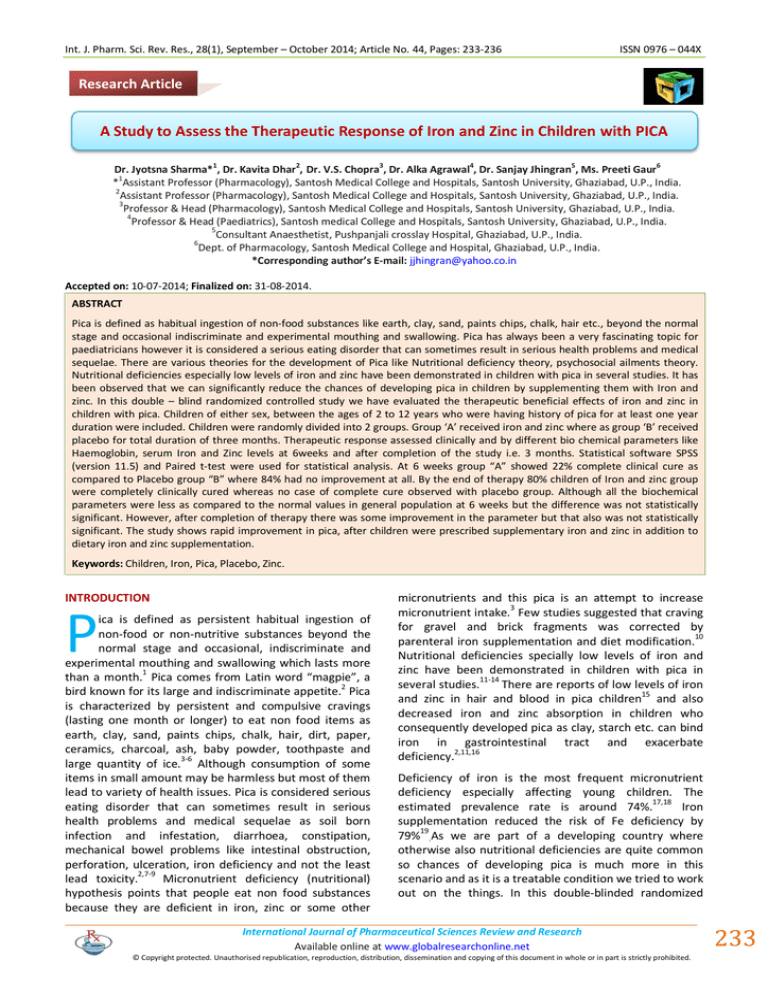
Int. J. Pharm. Sci. Rev. Res., 28(1), September – October 2014; Article No. 44, Pages: 233-236 ISSN 0976 – 044X Research Article A Study to Assess the Therapeutic Response of Iron and Zinc in Children with PICA 1 2 3 4 5 6 Dr. Jyotsna Sharma* , Dr. Kavita Dhar , Dr. V.S. Chopra , Dr. Alka Agrawal , Dr. Sanjay Jhingran , Ms. Preeti Gaur 1 * Assistant Professor (Pharmacology), Santosh Medical College and Hospitals, Santosh University, Ghaziabad, U.P., India. 2 Assistant Professor (Pharmacology), Santosh Medical College and Hospitals, Santosh University, Ghaziabad, U.P., India. 3 Professor & Head (Pharmacology), Santosh Medical College and Hospitals, Santosh University, Ghaziabad, U.P., India. 4 Professor & Head (Paediatrics), Santosh medical College and Hospitals, Santosh University, Ghaziabad, U.P., India. 5 Consultant Anaesthetist, Pushpanjali crosslay Hospital, Ghaziabad, U.P., India. 6 Dept. of Pharmacology, Santosh Medical College and Hospital, Ghaziabad, U.P., India. *Corresponding author’s E-mail: jjhingran@yahoo.co.in Accepted on: 10-07-2014; Finalized on: 31-08-2014. ABSTRACT Pica is defined as habitual ingestion of non­food substances like earth, clay, sand, paints chips, chalk, hair etc., beyond the normal stage and occasional indiscriminate and experimental mouthing and swallowing. Pica has always been a very fascinating topic for paediatricians however it is considered a serious eating disorder that can sometimes result in serious health problems and medical sequelae. There are various theories for the development of Pica like Nutritional deficiency theory, psychosocial ailments theory. Nutritional deficiencies especially low levels of iron and zinc have been demonstrated in children with pica in several studies. It has been observed that we can significantly reduce the chances of developing pica in children by supplementing them with Iron and zinc. In this double – blind randomized controlled study we have evaluated the therapeutic beneficial effects of iron and zinc in children with pica. Children of either sex, between the ages of 2 to 12 years who were having history of pica for at least one year duration were included. Children were randomly divided into 2 groups. Group ‘A’ received iron and zinc where as group ‘B’ received placebo for total duration of three months. Therapeutic response assessed clinically and by different bio chemical parameters like Haemoglobin, serum Iron and Zinc levels at 6weeks and after completion of the study i.e. 3 months. Statistical software SPSS (version 11.5) and Paired t­test were used for statistical analysis. At 6 weeks group “A” showed 22% complete clinical cure as compared to Placebo group “B” where 84% had no improvement at all. By the end of therapy 80% children of Iron and zinc group were completely clinically cured whereas no case of complete cure observed with placebo group. Although all the biochemical parameters were less as compared to the normal values in general population at 6 weeks but the difference was not statistically significant. However, after completion of therapy there was some improvement in the parameter but that also was not statistically significant. The study shows rapid improvement in pica, after children were prescribed supplementary iron and zinc in addition to dietary iron and zinc supplementation. Keywords: Children, Iron, Pica, Placebo, Zinc. INTRODUCTION P ica is defined as persistent habitual ingestion of non-food or non-nutritive substances beyond the normal stage and occasional, indiscriminate and experimental mouthing and swallowing which lasts more than a month.1 Pica comes from Latin word “magpie”, a bird known for its large and indiscriminate appetite.2 Pica is characterized by persistent and compulsive cravings (lasting one month or longer) to eat non food items as earth, clay, sand, paints chips, chalk, hair, dirt, paper, ceramics, charcoal, ash, baby powder, toothpaste and large quantity of ice.3-6 Although consumption of some items in small amount may be harmless but most of them lead to variety of health issues. Pica is considered serious eating disorder that can sometimes result in serious health problems and medical sequelae as soil born infection and infestation, diarrhoea, constipation, mechanical bowel problems like intestinal obstruction, perforation, ulceration, iron deficiency and not the least lead toxicity.2,7-9 Micronutrient deficiency (nutritional) hypothesis points that people eat non food substances because they are deficient in iron, zinc or some other micronutrients and this pica is an attempt to increase micronutrient intake.3 Few studies suggested that craving for gravel and brick fragments was corrected by parenteral iron supplementation and diet modification.10 Nutritional deficiencies specially low levels of iron and zinc have been demonstrated in children with pica in several studies.11-14 There are reports of low levels of iron and zinc in hair and blood in pica children15 and also decreased iron and zinc absorption in children who consequently developed pica as clay, starch etc. can bind iron in gastrointestinal tract and exacerbate deficiency.2,11,16 Deficiency of iron is the most frequent micronutrient deficiency especially affecting young children. The 17,18 estimated prevalence rate is around 74%. Iron supplementation reduced the risk of Fe deficiency by 19 79% .As we are part of a developing country where otherwise also nutritional deficiencies are quite common so chances of developing pica is much more in this scenario and as it is a treatable condition we tried to work out on the things. In this double-blinded randomized International Journal of Pharmaceutical Sciences Review and Research Available online at www.globalresearchonline.net © Copyright protected. Unauthorised republication, reproduction, distribution, dissemination and copying of this document in whole or in part is strictly prohibited. 233 © Copyright pro Int. J. Pharm. Sci. Rev. Res., 28(1), September – October 2014; Article No. 44, Pages: 233-236 ISSN 0976 – 044X controlled study we have evaluated the therapeutic beneficial effects of iron and zinc in children with pica. was done to ensure compliance with iron and zinc therapy and to assess their side-effects, if any. MATERIALS AND METHODS Different bio chemical parameters were taken at the start of study like Haemoglobin, serum Iron and Zinc levels. Children were advised to revisit OPD every two weeks and assessed for therapeutic response at 6 weeks and after completion of the study i.e. 3 months. The study was conducted in accordance with ethical standards of the institutional committee. Statistical software SPSS (version 11.5) and Paired t­test was applied for statistical analysis of the observations. A total of 100 children with pica from the outpatient department of paediatrics, who gave written informed consent, were studied. Children of either sex, between the ages of 2 to 12 years who were having history of pica for at least one year duration were included. Mentally challenged children, pica of duration less than a year, children < 2 years and >12 years were excluded from the study, as in children aged 18mths to 2 yrs , the ingestion and mouthing of non-nutritive substances is common and not considered pathological. Children were randomly divided into 2 groups. Group ‘A’ received iron and zinc where as group ‘B’ received placebo for total duration of three months. Iron was given as ferrous ascorbate syrup in the dose of 3 mg/kg/d and Zinc was used as zinc acetate syrup in the dose of 10 mg/day. Placebo was dispensed in the similar looking bottles. A close follow up After 6 weeks RESULTS Table 1: Mean duration of pica and Mean Hb Children with Pica Group ‘A’ Group ‘B’ Mean duration of pica 2.2±1.02 yrs 1.96±0.96 yrs Mean Hb 8.39±1.39 g/dl 8.02±1.01 g/dl After 3 months Figure 1: Response to treatment in group “A” After 6 weeks After 3 months Figure 2: Response to treatment in group “B” RESULTS AND DISCUSSION Demographic profile was comparable in both the groups. There was no significant difference between the age and sex of both the groups. Mean duration of pica was 2.2 ± 1.02 yrs. and 1.96 ± 0.96 yrs. in group ‘A’ and ‘B’ respectively. Mean Hb in group ‘A’ was 8.39 ± 1.39 g/dl and in group ‘B’ was 8.02 ± 1.102 g/dl (Table 1). So mean duration of Pica and mean Haemoglobin concentration was also comparable and there was no statistically significant difference was observed in them. Mean plasma levels of zinc and iron were lower as compared to normal levels in general population but again the difference was not statistically significant and they were comparable in both the groups. Mean plasma Iron and zinc levels were 48.3±6.6, 98.7±8.5 in Group ‘A’ and it was 49.1±2.2, 98.9±9.2 in group ‘B” respectively. At 6 weeks response to treatment was assessed. It showed that clinically in group with Iron and Zinc 4% patient had no change, 24% patient had some change, 50% had moderate change and 22% completely cured in comparison to placebo where 84% had no change, 16% had mild change and no children had come up with International Journal of Pharmaceutical Sciences Review and Research Available online at www.globalresearchonline.net © Copyright protected. Unauthorised republication, reproduction, distribution, dissemination and copying of this document in whole or in part is strictly prohibited. 234 © Copyright pro Int. J. Pharm. Sci. Rev. Res., 28(1), September – October 2014; Article No. 44, Pages: 233-236 moderate change and complete cure (Figure 1,2,3). Mean Hb was 8.6±1.2. Fe and zinc levels were 48.4±3.2 and 98.5±4.4 in group ‘A’ whereas it was 49.3±8.4 and 98.9±6.2 in group ‘B’. At the end of therapy i.e. at 3 months in group ‘A’ clinically 4% children showed some change, 16% moderate change, 80% completely cured in comparison ISSN 0976 – 044X to group ‘B’ where 76% showed no change and 24% showed only mild change , no completely cured case was observed (Figure 1,2,3). Mean Hb was 8.64± 13.7Mean plasma Iron level were 49.8±2.3 and 49.6±8.2 in group ‘A’ and group ‘B’ respectively whereas mean plasma zinc levels were 99.6±9.3 and 99.8±6.6 . After 6 weeks After 3 months Figure 3: Clinical response of treatment in both the groups Management of this eating disorder i.e. Pica is one of the greatest challenges faced by our countries paediatricians, owing to the higher prevalence rate, complexity of its etiopathogenesis and associated nutritional deficiencies. As this question is often raised whether low level of iron and zinc are the cause of pica or they are the effect of pica, several studies support the hypothesis that low level of iron and zinc are the cause of pica and not it’s effect 11, 20-24 .It is documented that zinc supplementation may lead to decrease in haemoglobin concentration but there are studies which state that usual doses of zinc does not produce any decrease in haemoglobin concentration.25 However few studies suggests that pica may be a cause of iron deficiency in which the non nutritive substances (e.g. clay etc.) interferes with the dietary intake and absorption of iron26-28 whereas With increasing emphasis on Iron and Zinc deficiencies in recent times in development and progression of this particular disorder, it’s worthwhile to take a note of the beneficial role of Iron and Zinc in Pica. There is theoretical risk of anaemia in zinc supplemented children due to inhibited iron transport. However, Meta analysis by Louise et al documented that zinc supplementation at doses typically used in randomised trials is quite safe and is not associated with decrease in haemoglobin concentration25. Lora et al documented that among iron deficient children haemoglobin concentration was improved with iron supplementation.18 Although there are several hypothesis stating about the different etiological factors for development of pica like nutritional theory, physiological theory etc.2,9,27, but deficiency of Iron and Zinc has been found to be most common entity associated with pica, like Singhi et al had demonstrated that plasma Fe levels in pica are almost 20% less than controls and Zinc levels were almost 45% less than control in children with pica.11 Few studies demonstrated low level of Iron in hairs of pica patients.15 So there are several studies which documents about the low plasma levels of zinc and iron associated with pica1114,17 and here also we could find these low levels but that was not significant enough as in other studies. We did not even find any significant changes in these biochemical parameters even after Iron and Zinc supplementations. However clinical improvement which observed during our study was awesome. This study shows that though there was no significant difference in the biochemical parameters as far as improvement is concern after children were prescribed supplementary iron and zinc in addition to dietary iron and zinc, but administration of iron and zinc was found significantly useful clinically in comparison to placebo in children with pica, as the P value found is quite significant (P value< .0001). Acknowledgement: We would like to thank Mr.Nand Kishore, Statistician for his valuable efforts and support during statistical analysis. We would also thank Mr. Nathilal for the technical assistance. REFERENCES 1. Cynthia R Ellis, Caroly Pataki. Pica, Medscape, 2013. 2. Advani Shweta, Kochhar Gulsheen, Chachra Sanjay, Eating everything except food (PICA): A rare case report and review, J IntSocPrev Community Dent, 4(1), 2014, 1-4. 3. Young SL, Jeffrey Wilson M, Dennis Miller, Stephen Hillier, Towards a comprehensive approach to the collection and analysis of Pica substances with emphasis on geophagic materials, Plos one, 9(3), 2008, e3147. International Journal of Pharmaceutical Sciences Review and Research Available online at www.globalresearchonline.net © Copyright protected. Unauthorised republication, reproduction, distribution, dissemination and copying of this document in whole or in part is strictly prohibited. 235 © Copyright pro Int. J. Pharm. Sci. Rev. Res., 28(1), September – October 2014; Article No. 44, Pages: 233-236 ISSN 0976 – 044X 4. Danford DE, Pica & Nutrition, Annu Rev Nutr, 2, 1982, 303322. in a tertiary care hospital in North India, Indian J Haematol Blood Transfus, 27(2), 2011, 75-80. 5. Reid RM, Cultural & medical perspectives on geophagia, Med Anthropol, 13, 1992, 337-351. 6. Donald Howorth, PICA-A case report, RACGP, 5, 2013, 42. 18. Lora L Lannotti, James M Tielsch, Maureen M Black, Iron supplementation in early childhood: health benefits and risks, Am J ClinNutr, 84(6), 2006, 1261-1276. 7. Glickman TL, Chaudhry IV, Constantino J, Clark FB, Cypess RH, Winslow I, Pica patterns, toxocariasis and elevated blood levels in children, Am J Trop Med Hyg, 30, 1981, 7780. 8. Phillips MR, Zaheer S, Drugas GT, Gastric trichobezoar: Case report and literature review, Mayo CliniProc, 7, 1998, 653656. 9. Christopher Rodgman, Daniel K. Winstead, A taste for the unusual. Current psychiatry, 12(3), 2013, 46-49. 10. PV Aparna, Austin RD, Matthew P, “PICA” Indian J Dent. Res., 23(3), 2012, 426-427. PMID 23059587. 11. Singhi S, Ravishanker R, Singhi P, Nath R, Low plasma zinc and iron in Pica, Indian Journal of Pediatrics, 70, 2003, 139143. 12. Sipahi T, Akar N, et al., Plasma zinc levels in patients with iron deficiency anaemia, J Trop Pediatr, 2, 2001, 122­123. 13. Federman DG, Kirsner RS, Federman GS, Pica: Are you hungry for the facts, Conn Med, 4, 1997, 207-209. 19. Michael Low, Ann Farrell, Effects of daily iron supplementation in primary–school-aged children: systematic review and meta-analysis of randomized controlled trials, CMAJ 17, 2013, 185. cmaj.130628. 20. Bhalla JN, Khanna PK, Srivastava JR, Sur BK, Bhalla M, Serum zinc levels in pica, Indian Pediatr, 19, 1983, 615­618. 21. Anselt JE, Wheby MS, Pica: Its relation to iron deficiency, VA Med Mon, 99, 1972, 951­954. 22. Khan Yasir, Tisman G, Pica in iron deficiency: A case series, Journal of medical case reports, 4(1), 2010, 86. 23. Kushner RF, Gleason B, Shanta-Retelny V, Re-emergence of pica following gastric bypass surgery for obesity; a new presentation of an old problem, J Am Diet Assoc, 104, 2004, 1393-1397. 24. Kettaneh A, Aclache V, Fain O, Sontag C, Uzan M, Carbillon L, Stimemann J, Thomas M, Pica and food craving in patients with iron deficiency anaemia: A case control study in France, Am J Med, 118(2), 2005, 185-188. 14. Shapiro MD, LInas SL, Sodium Chloride Pica secondary to iron deficiency anaemia, Am J Kidney Dis, 5, 1985, 67-68. 25. Louise H Dekker, Eduardo Villamor, Zinc supplementation in children is not associated with decrease in Hemoglobin concentrations, J. Nutr, 140(5), 2010, 1035-1040. 15. Chen XC, Y In TA, He HS, Ma QY, Han Zm, Li LX, Low levels of zinc in hair and blood, pica, anorexia and poor growth in Chinese pre­school children, Am J CliNutr, 45, 1985, 694. 26. Barton J. Blinder, An update on pica: Prevalence, contributing causes and treatment, Psychiatry times May 2008. 16. Arcasoy A, Cavadar AO, Babacan E, Decreased iron and zinc absorption in Turkish children with iron deficiency and geophagia, ActaHaematol, 60, 1978, 76-84. 27. Cavdar AO, Arcasoy A, Cin S, et al., Geophagia in Turkey: iron and zinc deficiency, ProgClinBiol Res, 129, 1983, 71­79. 17. Mahajan Garima, Sikka M, Rusia U, Bhatia MS, Iron profile in children with behavioural disorders: A prospective study 28. Leming PD, Reed DC, Martelo OJ, Magnesium carbonate pica: An unusual case of iron deficiency, Ann Intern Med, 94, 1981, 660. Source of Support: Nil, Conflict of Interest: None. International Journal of Pharmaceutical Sciences Review and Research Available online at www.globalresearchonline.net © Copyright protected. Unauthorised republication, reproduction, distribution, dissemination and copying of this document in whole or in part is strictly prohibited. 236 © Copyright pro
